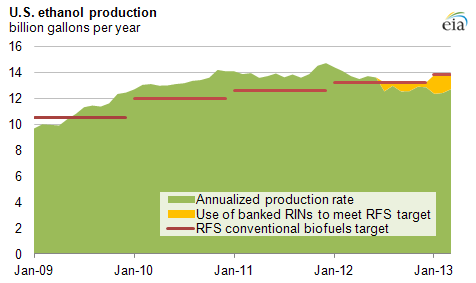
U.S. ethanol production and the Renewable Fuel Standard RIN bank

Note: RFS line represents the implied annual conventional biofuels portion of the RFS target, which primarily includes corn ethanol.
Renewable Identification Numbers (RINs) form the mechanism used by the Environmental Protection Agency (EPA) to record compliance with the Renewable Fuel Standard (RFS), which began in 2005 and was revised in 2007 as part of the Energy Independence and Security Act of 2007 (EISA). Beginning in 2009, U.S. ethanol production began to grow beyond the targets set by the RFS, leading to an increasing supply of banked RINs through 2012.
U.S. corn ethanol production grew considerably from 2006 through 2012, boosted by the phase-out of the use of Methyl tertiary-butyl ether (MTBE) as an oxygenate and octane enhancer, the availability of blender tax credits, and rising oil prices. Ethanol production and use grew beyond levels called for by the RFS as early as 2006. U.S. ethanol production and use continued at rates beyond the RFS-mandated level through mid-2012. Under these circumstances, there was an excess supply of RINs that were banked for future compliance.
U.S. ethanol production in the first half of 2012 averaged about 900,000 barrels per day (bbl/d), or an annualized total of 13.8 billion gallons. Widespread drought across corn-producing regions in the Midwest reduced corn harvests, and as a result ethanol production rates began to decrease. Ethanol production in the second half of 2012 fell to an average of 830,000 bbl/d, or an annualized total of about 12.7 billion gallons. After accounting for ethanol exports, which do not provide RINs for RFS compliance, this lower ethanol output in the second half of 2012 led to corn ethanol consumption falling an estimated 600 million gallons short of the 13.2 billion gallons expected for the 2012 RFS target. This shortfall was met, for the first time, by a drawdown of banked RINs.
The available bank of corn ethanol RINs was estimated at 2.1 billion gallons after the drawdown for 2012 RFS compliance purposes, while the total supply of all banked RIN classifications (including biomass-based diesel and advanced biofuels) was estimated at 2.7 billion gallons.
While effects of the drought are expected to linger and influence ethanol production levels through the first half of 2013, the larger issue going forward is the 10% ethanol blend wall. The blend wall limits ethanol consumption in E10 gasoline to about 13.3 billion gallons because motor gasoline consumption is projected to reach 133 billion gallons in 2013 (April 2013 Short-Term Energy Outlook).
There is an additional constraint imposed by the growing advanced biofuels mandate under the RFS, which can be met using either biodiesel or imported sugarcane ethanol. Sugarcane ethanol competes with corn ethanol in the E10 blending pool and reached almost 500 million gallons in 2012. With the proposed increase in the total RFS target for 2013 and the possibility of a further increase in 2014 absent a decision by EPA to lower the legislated target for advanced biofuels, the constraint on the amount of ethanol that can be absorbed in E10 blending could limit ethanol use and, therefore, future availability of RINs. Depending on the ability of corn harvests and ethanol production to recover in 2013 as well as the availability of greater ethanol blends such as E15 or E85 to penetrate the market, the corn ethanol RIN bank of 2.1 billion gallons could potentially fall to zero in 2014.